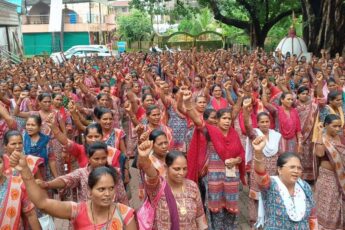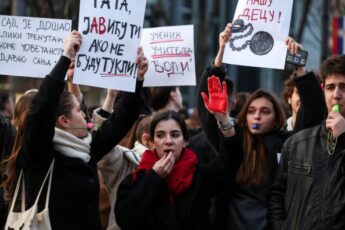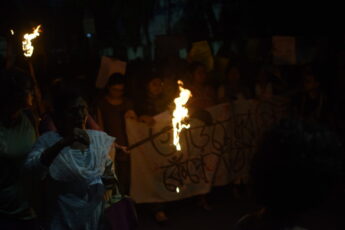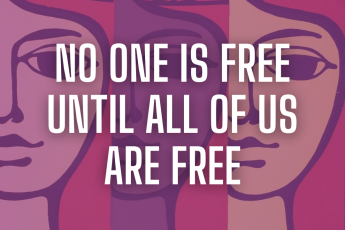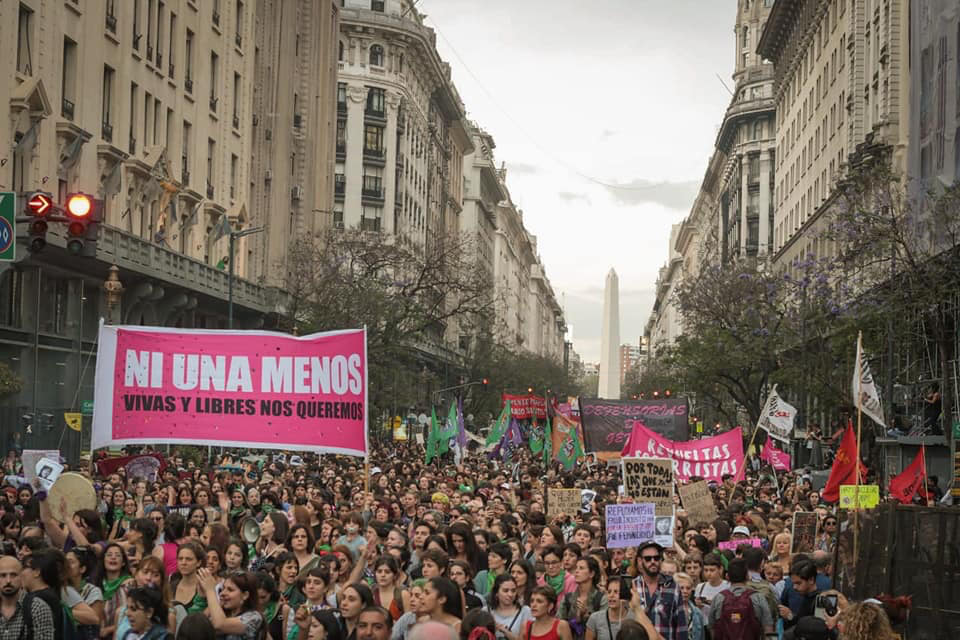
by ELEONORA CAPPUCCILLI (Precarious Diʃconnections)
(translated by Charline Kopf)
During the last TSS meeting in Stockholm we discussed about how to foster and boost next global women’s strike on 8th of March 2019 as a fundamental moment of the transnational struggle against exploitation and the patriarchal and racist hierarchies imposed to intensify it. The following interview (translated into English from www.connessioniprecarie.org) is meant to contribute to our discussion on global women’s strike and 8th of March 2019. In it, Eleonora Cappuccilli talks with Raquel Gutierrez Aguilár and Verónica Gago about the feminist strike and forthcoming mobilisations in Argentina and Latin America. The interview was held on 26th October 2018, shortly after the 33rd National Women’s Meeting in the city of Trelew, in the province of Chubut. The meeting took place amidst the rapid advancement of President Mauricio Macri’s neoliberal economic policies – indeed, despite large street demonstrations, Argentina’s Senate approved the austerity budget agreed with the IMF – and the success of Jair Bolsonaro in Brazil. Raquel is a feminist philosopher, sociologist and mathematician from Mexico, who was active in the Bolivian guerrilla warfare in the 1980s and 1990s. Verónica, who also contributed to our reader “Power Upside Down. Women’s Global Strike”, is a scholar engaged in the study of social movements and part of the Argentine collective Ni Una Menos. Their words reveal how the feminist strike has enabled to intertwine and transform the struggles that have shaken South America for decades, creating and extending an unprecedented space for connection and politicisation. This, however, has not been a spontaneous process. On the contrary, the ability to break the confines of a “sectoral” campaign, successfully bringing together the fight against male violence and the fight for safe and free abortion, is the result of multiple moments of encounter and mobilisation in recent years. The traits that define the ‘multitudinous’ character of the assemblies in Rosario, Chaco and Trelew are both their mass dimension and their composition as an ensemble of different singularities. The “plurinational” nature of the movement defines a field of tension in which the recognition of the colonial past – denounced in the first place by indigenous communities and the urban ones of the “villas” – suggests the need to question the sexualised and racist social hierarchies that configure the relationship between the reproduction of life and workforce as well as define the conditions of production. Far from painting a complete, idealised and conclusive picture of current struggles, this interview rather reflects on the problems, and challenges that the organisation of mass mobilisation poses. This becomes even more urgent in light of the authoritarian twist which the repressive measures by the Macri government and the Bolsonaro election in Brazil testify to. Last week another powerful women’s strike took place in Argentina, protesting against a whole system perpetuating and reproducing male violence against women. Hundreds of collectives, movements, trade unions and hundreds of thousands of people took to the streets against the sentence of the court which acquitted the killers of Lucía Perez, drugged, raped, impaled and killed in 2016. This episode of violence was the spark of the first women’s strike in Argentina. If, through feminism, the strike manifests itself as a moment of class struggle on a global scale, it is still a matter of probing its capacity for duration and rupture.
Eleonora Cappuccilli: Let’s talk about the Trelew meeting. There has always been a mass participation element to the meetings, but has anything changed after the global feminist strike and the Ni Una Menos movement, in terms of political initiative and of the discourses not only about women but in general?
Verónica Gago: The sequence of events can actually be reversed. It all started when we came back from the Women’s Meeting in Rosario in 2016, when we had seen what had happened in Mar de Plata – the murder of Lucia Perez. There was a strength and energy that we had drawn not only from the meeting, but above all from the widespread feeling caused by the discovery of this body, the corpse; the feeling that it had been a form of protest against us. It happened after the meeting in Rosario, which has been the most multitudinous in history (we were 80,000). There was this sort of collective energy that we felt and the perception that there had been an attempt to attack and threaten it. The sense that there was a direct link between this crime and the deployment of our collective energy. It was all of this that triggered the first national women’s strike. At the 2017 meeting that was held in the city of Resistencia, in the province of Chaco – which was also a very large meeting – the intertwining between the national women’s strike and the international one in 2017 became very clear.
What is interesting is that we got to this meeting after having organised a Ni Una Menos assembly with feminist collectives and companions of the Mapuche community in El Bolsón about the criminalisation of the Mapuche struggle for the recovery of their territories. This discussion was powerfully taken up at the meeting in Chaco, where we decided that the next meeting had to take place in the south of the country, in Patagonia, to ensure that the power of the discussion would accompany the struggles unfolding there. We should bear in mind that last year, in 2017, state repression reached new heights that led to the disappearance and death of the activist Santiago Maldonado and to the killing of the young Mapuche Rafael Nahuel at the hands of the Argentinian state. In addition, the supreme court made an attempt – that eventually failed – to rule in favour of the military through the law known as dos por uno (2×1) that would have reduced the prison sentences of those guilty of genocide. Luckily, the street demonstrations prevented the passing of the law. Nonetheless, it was clear that this attempt went hand in hand with the repressive, state-sponsored policies that were particularly frequent last year. Here, it seems to me that one can identify an emerging trend that concerns both the strike and the form that the dispositive of assemblies takes: This is what laid the foundations of the feminist strike and is also the result of the possibility that was offered by holding an assembly in the south of the country, a decision that was first suggested at the Chaco meeting. This year’s meeting that has just come to an end and which was held in the southernmost place in the history of these meetings reflects this path, this trajectory. It also testifies to a growing accumulation linked to the 8th of March strike and to the entire mobilisation of the so-called “green tide“, i.e. the campaign to legalise abortion, which had as its epicentre a two-day “vigil” held during the abortion vote in the Senate and Chamber of Deputies. These days of “vigil” resulted in great mass protests not only here in Buenos Aires, but also in the rest of the country.
For me, this meeting in Trelew can be read, in some ways, as the first large-scale response to the type of regulation that they want to impose through the rejection of the abortion bill in the Senate. I believe that a relationship is developing between the meetings and the different political events that not only concerns the strike – and the strike is very important – but also the dynamics of the assemblies and of the social conflict. What seems interesting to me, if we talk about Ni Una Menos as a movement, is that it manages to intensify itself when it is connected to social conflict, i.e. when it breaks out of the confines of a narrow understanding of gender violence that posits women only as victims. It is this type of connection and positioning that allows us to create a certain political proximity with other struggles.
EC: What is the relationship between the declared “plurinational” character of this movement, affirmed at Trelew, and the feminist character of the strike, which is global, social and transnational?
Raquel Gutierrez Aguilár: Two elements have to be considered when talking about “plurinational”. At Trelew, there were discussions about a multinational meeting, but it was not clear whether this would lead to the claims for a plurinational state. We chanted “multinational meeting” until we lost our voices. This means that we are talking and thus also asserting, by singing together, that there is a will to deconstruct hierarchy. The proximity of the struggles, which is a way of cultivating rapprochements in a series of “key moments”, requires the deconstruction of hierarchies, in particular the hierarchy that has marked the colonial moment. In 1871, less than 150 years ago, the conflict between the Argentineans moving southward and the Mapuche communities was still ongoing, leading to the conquest of territory and violation of indigenous women, as well as the abduction of white women through the so-called Indian raid. We continue to see this now, at a different time. The meeting has declared itself as plurinational to break with the colonial wound, but perhaps it can also be considered transnational, because we will not return to the nation. It is not about passing a logical reasoning test, but about saying what we want.
VG: Another interesting point is how we discussed it. This was unprecedented, as there had never been such an important discussion on the plurinational and the indigenous question in any meeting. What also allowed for its amplification, is that its plurinational character was discussed not only in terms of identity but in terms of concrete conflicts: What would the resistance against the mine look like? What is the ongoing fight in relation to the contaminated water about? Why is Benetton the main landowner in Patagonia? What does the expansion of soybeans have to do with the evictions of peasants in the north of the country? How does this come to bear on the informal property market in the urban areas of Buenos Aires? Why do those driven out of certain provinces move towards the outskirts of the city? We began discussing the matter of the indigenous, popular and communitarian dimensions, starting from the question of what it meant to build on the foundations of the struggles, as identities founded by the struggles. They did not want to be simply “folklorised” in thematic working groups, as one comrade put it. The plurinational character has shown that it has the unprecedented capacity to be transversal. Moreover, it is no accident that the question of the plurinational occurs as a displacement on its own when the meeting is also held in the name of women, lesbians, transsexuals and transvestites. It is a multiplication that cannot be reduced to either a question of identity nor to a question of state-form, but to the problem of encounter and experiences of conflict.
RGA: The question was, ‘how are we going to achieve something?’ Everyone in their own way, but within the feeling of inclusion that we are producing. So, we said to ourselves: No one precedes us. We are producing what we are and what we do to achieve something. It is different to invent the concept and then to negotiate it, or to produce the inclusion that we need and then try to achieve it. It is very interesting that this happened at a time marked by the powerful support for the need for plurinationality, which was not a demand but an action by the Mapuche to include themselves in the diversity in order to pluralise themselves. It is this sense of inclusion that was built at the march. In Spanish, it is a pun: en marcha means both “during the march / during the protest”, or “on the move / in movement”. It was in fact a mixture of slogans. Every now and then, trans prostitutes with their specific claims shouted “No racism! No racism!”, while other organisations of the popular economy and in the neighbourhoods, making signs to each other, shouted “popular power!”, which they then combined with “ancestral power”! There was a fire of ancestral power that manifested itself amongst native women. For brief moments, they exchanged their own slogans: “Popular power! Ancestral power! ” It is not a definition, but a search for an intertwining. It is a multitude of actions of each and everyone that are happening at the same time. It’s very strange. It was a very effervescent experience, like a desire to weave a plot.
EC: It seems to me that this effervescence, this expression, ‘no one precedes us’ is a novelty.
RGA: Novelty does not necessarily mean that it has been a spontaneous process.
EC: I am not talking of a spontaneous process but rather that in this intertwinement of struggles as, for example, in the prostitutes’ fight against racism, there is something new that gives strength.
RGA: Yes and no. It is a revival of what has been happening in other moments of uprising when you put aside the boxes that contain you. In each uprising, you put aside the boxes that were built to manage you. The politics of sexual difference is an act of challenging and rejecting the man / woman boxes. From a theoretical point of view, this is an important movement of disidentification and counter-identification that renders association possible.
VG: For me, it radicalises what we are doing with the project of the strike, which, drawing on the concept of the Mujeres Creando, we define as “unusual alliances.” These do not occur spontaneously but require an effort of interweaving to allow for a proximity between these struggles to emerge.
RGA: It involves the labour of weaving, of cultivating strong ties, of efforts.
VG: … even of misunderstandings …
RGA: … of negotiations …
VG: The assembly in El Bolsón was very tough. The comrades of the community said: “You, feminists, never mobilise for our dead.” It has not been an idyllic process…
EC: Going back to the freedom of legal and safe abortion, what will change now that the Senate has rejected the bill despite the mass mobilisation? We are talking about an issue that is Argentinian but at the same time global, because there are attempts to reform and limit it all over the world.
VG: It must be said that the mobilisation for abortion has a long and a short history in Argentina. The long one concerns the thirteen-year-old national campaign that unites those feminists who, in the last decades, have been fighting for the right to free and safe abortion through a number of legislative initiatives by engaging in different forms of campaigns within the framework of women’s meetings. The shorter one concerns this year’s large-scale attendance which has been unprecedented in its scope. How to explain this development? A paradox lies behind this question: When we were preparing the 8th of March 2018 strike, i.e. this year’s strike, Macri’s government said it would engage with the issue of abortion on 8th of March. This led to a great deal of discussions in the assemblies and to our decision to march not only until the Plaza de Mayo – as we had done on the previous 8th of March – but until the Congress. When the assembly took this decision, Macri said: “No, it’s best not to discuss the matter of abortion on 8th of March. We’ll see when we’ll do it.” That was a very clear strategy by the government to narrow down the very broad and radical agenda of the strike to the issue of abortion and its legislative framework. In fact, many of the government’s criticisms made through official media targeting the document that we read on 8th of March 2018 – a thoroughly political document crafted and drafted in the assembly that is not restricted to the question of women – rested on the accusations that we were politicised, that we mixed up everything and had stopped talking about gender-based violence.
Yet, the intention is precisely to limit ourselves to the restricted discussion on abortion. However, the movement has been so strong that it has surpassed and exceeded this maneuver so that the discussion about abortion has spread everywhere. There are two main protagonists: First, secondary school students, who have organised large-scale protests in the last two years linking the issue of abortion to the demand for comprehensive sexuality education in schools and the struggle against precarity, thus going against government plans in public school. In this way, they have taken up and interpreted the campaign for abortion in a very radical manner. The other protagonists are the organisations from the villas. Their slogan “we women of the villas abort” opposes the very strong discourse that the so-called church of the poor, i.e. the “villera church,” tries to impose which maintains that the question of abortion is a middle-class demand made by white middle-class women. In this regard, the question of abortion is posed in classist and racist terms. We began discussing the matter of free abortion that divides those who can have it in clandestine but unsafe conditions from those who can have it in clandestine but safe conditions, because they can obviously pay for this safety.
EC: Faced with the probable election of Bolsonaro [the presidential elections in Brazil had not yet taken place at the time of the interview], what are you organising in Argentina and Latin America?
VG: In December, there will be meeting of Latin American feminisms to discuss, more broadly, the question of a front against Bolsonaro, the issues of fascism and feminism in the region, or in other words, how to deal with the fascist response to the feminist mobilisation.
EC: What strikes me as particularly important, is the transnational and continental character of the attempt to speak out. Is this a novelty for you too?
VG: The international strike has produced a transnational dimension, and the two most dynamic elements of today’s internationalised struggles are strikes and migration. This is also why they are being attacked and criminalised. In the last two years, feminism has produced an internationalism that is very different from how internationalism was thought of at other times.
RGA: We are used to thinking in terms of apparatuses that can contribute to articulating internationalism in the form of national apparatuses that are coalescing. Here, we are at a turning point in understanding the fundamental ways in which a shared and common feeling is produced and how it resonates with others. In fact, we are talking about a nineteenth-century heritage that can be traced back to the end of the First International and the strike for the eight-hour day. So, I would rather put it like this: The aim is to regain this possibility of struggle and to take up the challenge of thinking about ways to not stabilise such struggle in the form of an apparatus that we are already familiar with – even though we still need to deal with the problem of duration.
EC: What are the plans for the next 8th of March? How will the feminist strike continue? How will it be articulated in relation to the migrant struggles?
VG: We have opened a consultation and research process on how to deal with the upcoming 8th of March. Right now, it seems to me that we are at a stage of producing a feminist analysis of fascism in the region, or what we have called a triple offensive: Military, religious and financial. What we will do from now on is to analyse the current moment with a particular attention to the kind of specificity that the next international strike will present in relation to these regional issues that are actually broader. The element of migration is very important to me. One of Ni Una Menos’ most interesting products, or rather variations, is Ni Una Migrante Menos. To me, this testifies to a concern that is specific to Argentina where the frame of reference is always articulated in relation to the nation-state and thereby systematically ignores – in the name of the people – the migrant question.
EC: Since we have touched on the problem of the people and differences, what is the relationship between the feminist strike – which is conceived as a tool against exploitation and speaks the language of class – and communitarianism that does not refer to class, but to the community? I.e. a feminist movement that cannot be defined in terms of community but in terms of mass? And, with the novelty now introduced by Ni Una Menos, how is the class dimension articulated in relation to other forms of belonging / identities (urban and indigenous communities, neighborhoods, cities …)?
VG: There is a stereotype surrounding communitarianism in relation to what we have already discussed, namely the idea that it is a type of confinement, a sort of closed space. Drawing on the experience of the feminist strike, we can delineate a labour composition that includes a number of elements dealing with migrants of the communities but in terms of workforce, as well as with the feminised labour sector and the exploitation of community networks upon which the latter relies. I would not oppose the idea of class to the one of community. I would rather suggest that today, if we think of class in terms of its composition looking at those who create value (i.e. at their political configuration), the communitarian dimension is internal to this class composition. This dimension allows one to reformulate an idea of class that was previously narrow, modern, white and Eurocentric. It seems to me that feminism – the practice of the feminist strike – allows us to discuss what it means to talk about class dynamic when the language or vocabulary that is used is not the one of class. I believe that it remains an open dynamic. How do we recognise that we are talking about class without remaining attached to a specific class vocabulary? How does one create a new vocabulary? The entanglement between patriarchy, colonialism and class renders it impossible to privilege one of the terms. I think this is what feminism reveals in current mobilisations, the kind of interconnections that are put into effect by it.
EC: We would say institutional racism and not colonialism. Why do you refer to colonialism?
VG: Because the colonial experience reappears constantly here, even when it is systematically denied, as in Argentina (unlike the Andean countries). Here there is a systematic denial of the colonial dimension of the states, of the foundation of the republic, and of the division of the labor force. I believe that it is possible to bring to the fore the indigenous and migrant struggles along with the feminist struggles.
EC: What is the relationship between the abortion law and the neoconservative policies of subcontinental neoliberalism – for example, the current debt policies in Argentina?
VG: It is a relationship that is fundamental. The discussion on abortion has grown to such an extent that it has caused a very strong reaction from the ecclesiastical power, from within the hierarchy of the Church, because feminism is indeed fighting in terms of spirituality and in terms of sovereignty over the body. Here the Church sees its power, its structure and economy of obedience being called into question.
EC: And what about the relation to debt, to economic policies?
VG: We already discussed this part earlier in terms of “triple offensive.” The financial aspect here in Argentina is linked to the adjustment plan at the macrostructural level, but there is also another element which is systematically denied but actually appears from all sides. By that I mean the level of private and family domestic indebtedness that has taken place over the last 10-12 years. This is consumer indebtedness and has not been at all problematised because it constituted a way of social inclusion by consumption favoured by progressive governments. All this is now exploding as domestic economy debt.


